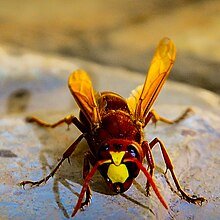| Hornet | |
|---|---|

| |
| Oriental hornet (Vespa orientalis) | |
| Scientific classification | |
| Domain: | Eukaryota |
| Kingdom: | Animalia |
| Phylum: | Arthropoda |
| Class: | Insecta |
| Order: | Hymenoptera |
| Family: | Vespidae |
| Subfamily: | Vespinae |
| Genus: | Vespa Linnaeus, 1758 |
| Type species | |
| Vespa crabro Linnaeus, 1758[1]
| |
| Species | |
|
See text | |
Hornets (insects in the genus Vespa) are the largest of the eusocial wasps, and are similar in appearance to yellowjackets, their close relatives. Some species can reach up to 5.5 cm (2.2 in) in length. They are distinguished from other vespine wasps by the relatively large top margin of the head. Worldwide, 22 species of Vespa are recognized.[2][3] Most species only occur in the tropics of Asia, though the European hornet (V. crabro) is widely distributed throughout Europe, Russia, North America, and north-eastern Asia. Wasps native to North America in the genus Dolichovespula are commonly referred to as hornets (e.g., baldfaced hornets), but all of them are actually yellowjackets.
Like other social wasps, hornets build communal nests by chewing wood to make a papery pulp. Each nest has one queen, which lays eggs and is attended by workers that, while genetically female, cannot lay fertile eggs. Most species make exposed nests in trees and shrubs, but some (such as Vespa orientalis) build their nests underground or in other cavities. In the tropics, these nests may last year-round, but in temperate areas, the nest dies over the winter, with lone queens hibernating in leaf litter or other insulative material until the spring. Male hornets are docile and do not have stingers.
Hornets are often considered pests because they aggressively guard their nesting sites when threatened and their stings can be more dangerous than those of bees.[4]
- ^ James M. Carpenter & Jun-ichi Kojima (1997). "Checklist of the species in the subfamily Vespinae (Insecta: Hymenoptera: Vespidae)" (PDF). Natural History Bulletin of Ibaraki University. 1: 51–92.
- ^ Archer, M.E. (2012). Penney, D. (ed.). Vespine wasps of the world: behaviour, ecology and taxonomy of the Vespinae. Monograph Series. Vol. 4. Siri Scientific. ISBN 9780956779571. OCLC 827754341.
- ^ A.H. Smith-Pardo, J.M. Carpenter, L. Kimsey (2020) The diversity of hornets in the genus Vespa (Hymenoptera: Vespidae; Vespinae), their importance and interceptions in the United States. Insect Systematics and Diversity 4(3) https://doi.org/10.1093/isd/ixaa006
- ^ Vetter, Richard S.; Visscher, P. Kirk; Camazine, Scott (1999). "Mass Envenomations by Honey Bees and Wasps". Western Journal of Medicine. 170 (4): 223–227. PMC 1305553. PMID 10344177.